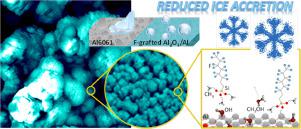Applied Materials Today ( IF 7.2 ) Pub Date : 2020-09-10 , DOI: 10.1016/j.apmt.2020.100815 Víctor Rico , Julio Mora , Paloma García , Alina Agüero , Ana Borrás , Agustín R. González-Elipe , Carmen López-Santos

|
Infusion of low surface tension liquids in nanostructured surfaces is currently used to promote an anti-icing response, although the long term stability of these systems is often jeopardized by losses of the infused liquid. In this work, we propose an alternative to the infusion procedure to induce a more effective and long lasting anti-icing capacity. The method consists of a combination of surface nanostructuration with the chemical grafting of fluorocarbon molecules. Al6061 substrates have been subjected to laser roughening and further modified with a nanostructured Al2O3 thin film to achieve a dual roughness and porous surface state. These surfaces have been subjected to a grafting treatment with perfluorooctyltriethoxysilane (PFOTES) vapor or, for comparative purposes, infused with a low surface tension liquid. A comparative analysis of the wetting, water condensation and anti-icing properties of these two systems showed an outstandingly better performance for the grafted surfaces with respect to the infused ones. Grafted surfaces were markedly superhydrophobic and required higher water vapor pressures to induce condensation. When looking for their anti-icing capacity, they presented quite long freezing delay times for supercooled water droplets (i.e. almost four hours) and exhibited a notably low ice accretion in a wind tunnel test. The high aging resistance and durability of these grafted surfaces and the reproducibility of the results obtained when subjected to successive ice accretion cycles show that molecular grafting is an efficient anti-icing methodology that, in aggressive media, may outperform the classical infusion procedures. The role of the fluorocarbon chains anchored on the surface in inducing an anti-icing functionality is discussed.
中文翻译:

通过接枝碳氟化合物分子链来实现坚固的防冰超疏水铝合金表面
尽管通常通过注入液体的损失来破坏这些系统的长期稳定性,但是将低表面张力液体注入纳米结构表面中目前被用于促进防冰反应。在这项工作中,我们提出了一种输液程序的替代方案,以诱导更有效和更持久的防冰能力。该方法包括表面纳米结构与碳氟化合物分子的化学接枝的组合。Al6061基板已经过激光粗糙化处理,并用纳米结构的Al 2 O 3进行了进一步改性薄膜实现双重粗糙度和多孔表面状态。这些表面已经用全氟辛基三乙氧基硅烷(PFOTES)蒸气进行了接枝处理,或者为了进行比较,还注入了低表面张力的液体。对这两个系统的润湿性,水凝结性和防冰性的比较分析表明,相对于注入表面而言,接枝表面的性能显着提高。接枝表面明显具有超疏水性,需要更高的水蒸气压力才能引起冷凝。当寻找其防冰能力时,它们对过冷水滴的冷冻延迟时间相当长(即近四个小时),并且在风洞试验中显示出极低的积冰量。这些接枝表面的高耐老化性和耐久性以及在接连不断的积冰循环后获得的结果的可重复性表明,分子接枝是一种有效的除冰方法,在腐蚀性介质中,其性能可能优于传统的输注程序。讨论了锚定在表面上的碳氟化合物链在诱导防冰功能中的作用。











































 京公网安备 11010802027423号
京公网安备 11010802027423号